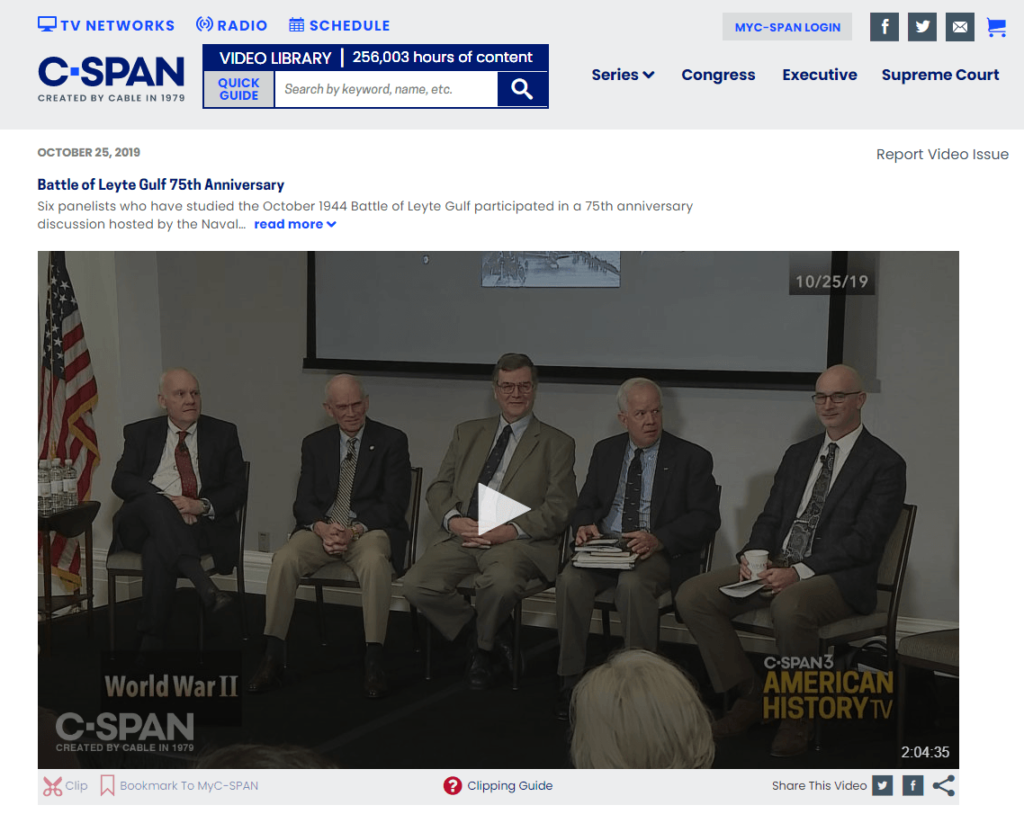
On October 25th, the Naval Historical Foundation hosted a symposium commemorating the 75th anniversary of the Battle of Leyte Gulf. C-SPAN graciously recorded the event for us and aired it earlier this week.
In case you missed it, C-SPAN has also published it online. Please click the image above to enjoy the footage of our highly distinguished panel.
Army Owned, Navy Operated: The Sinking of USS Cairo in Rural Mississippi
While the United States Navy owns and operates the majority of large sea-going vessels in the U.S. Military today, the Coast Guard and Marine Corps also utilize their own watercraft. Most people, however, would be surprised to learn that the U.S. Army has periodically possessed maritime equipment throughout its history, including transport ships.
One fascinating piece of this history is the Army owned and operated (albeit briefly) Western Gunboat Fleet, also known as the Mississippi River Squadron. This small fleet, composed of some of the first Ironclads as well as monitor ships, support vessels, and the lesser known ‘tin-clad’ vessels. The fleet was also the first to be dubbed a ‘brown-water‘ navy, and was instrumental in general-in-chief Winfield Scott’s Anaconda Plan to blockade Confederate ports and access to the sea.
One of the vessels in the Squadron was the USS Cairo. Cairo was a City-class gunboat built in Illinois and commissioned on 25 January, 1862. Over the following months, the 175-foot Cairo and her complement of 251 officers and men participated in actions along the Mississippi River, including battles near Nashville and Memphis, Tennessee.
In October of that same year, the United States Army transferred the ship to the Union Navy. Major General Ulysses S. Grant, was intent on capturing the last remaining Confederate stronghold on the Mississippi River – the fortified city of Vicksburg, Mississippi. In the lead up to the major operations of 1863 under Grant’s supervision, the Union Navy patrolled the vast river network of northern Mississippi. Cairo was ordered on one such patrol in December of 1862.
The National Park Service documents the events of that fateful patrol below:
____________________________________________________________________________
On December 12, 1862, the USS Cairo was busy clearing Confederate torpedoes (today called underwater mines) from the muddy Yazoo River. Upon hearing small arms fire, Commander Selfridge thought his vessel was under attack and ordered Cairo into position. Two Confederate sailors, Acting Masters Zedekiah McDaniel and Francis M. Ewing, names now lost to history, hid behind a river bank and waited as the Cairo maneuvered to the front of the flotilla.
At the right moment, the two Confederates detonated the torpedoes with an electric charge. Two explosions ripped a large hole in the port bow causing the Cairo to quickly fill with water. Within 12 minutes, it sank to the bottom in six fathoms (36 feet) of water, but with no loss of life. The USS Cairo became the first armored warship in history to be sunk by an electronically detonated mine.
Soon after the sinking the youngest crew member, fifteen year old George Yost, penned an account of the Cairo’s final moments:
“…just as we were training on the battery we were struck by a torpedo, which exploded under our starboard bow, a few feet from the center and some 35 or 40 feet from the bow proper just under our provision store room, which crushed in the bottom of the boat so that the water rushed in like the roar of Niagara. In five minutes the Hold was full of water and the forward part of the gunboat was flooded…One of our heaviest bow guns had been dismounted by the force of the explosion injuring three men.”
(Retrieved from: www.nps.gov/vick/learn/historyculture/explosion-sinks-the-uss-cairo.htm)

Just a few months after the sinking of the Cairo, a full-scale Naval effort in northwest Mississippi was launched to help break through the Confederate defenses of Vicksburg. The “Yazoo Pass Expedition,” lasted from February to April of 1863. It, too, failed, in large part to the tight, winding river paths, dense tree cover, and easy counterattack from Confederate defenders.
Read more about the Cairo, as well as modern issues in Army-Navy and Marine Corps-Navy inter- service on rivers, seas, and oceans, from the articles below.

